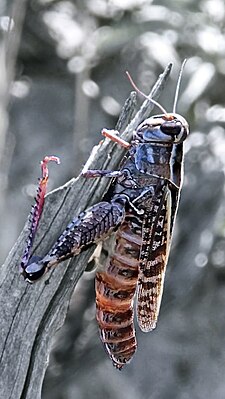Entomophaga grylli
| Entomophaga grylli | ||||||||||
|---|---|---|---|---|---|---|---|---|---|---|

Calliptamus female infected with Entomophaga grylli with distended abdomen |
||||||||||
| Systematics | ||||||||||
|
||||||||||
| Scientific name | ||||||||||
| Entomophaga grylli | ||||||||||
| Fresen . |
Entomophaga grylli (no German name, synonyms: Conidiobolus grylli (Fresen.) Remaud. & S. Keller, Empusa grylli (Fresen.) Nowak., Entomophthora grylli Fresen.) Describes a species complex or pathotypes of fungi occurring on all continents, the Infested with locusts. The taxonomy of Entomophaga grylli has not yet been finalized; preliminary names have been given for three species that can be distinguished by DNA analysis. The individual types specialize in certain families or genera of locusts and are harmless to other species. Infestation with Entomophaga grylli usually leads to death of the host within about 4 to 16 days; mortality varies between 9 and 100%.
Change of behavior of the host
The fungus causes several behavioral changes in the host. The tendency of the locusts to relocate in dense populations decreases, so that the fungus can spread better locally. Before the death of the affected grasshopper tried an increased space, like the tip of a plant to climb and cling there, from where can spread the spores of Entomophaga grylli better infestation is therefore " summit illness called". This usually happens in the evening hours, when the spore spread is favored by increased humidity. Some grasshopper species can prevent or at least slow down the growth of fungi by actively changing their body temperature (sunbathing).
Fruiting bodies
The reproduction takes place in the form of cell-wall-less protoplasts inside the grasshopper, initially outside the cells or in the fat body; the fungus forms hyphae with cell walls to form spores. Muscles and vital organs are only attacked after the host dies. The mycelium consists of simple, mostly only slightly branched tubes. The conidia are 34 to 40 µm long and 25 to 37 µm wide, the round permanent pores have a diameter of 34 to 40 µm.
Life cycle
The grasshopper is infected by spores that penetrate the body through the cuticle , where the fungus multiplies, the abdomen is inflated and stretched so that the pleural membranes become visible and a striped pattern is created. The fungus forms both permanent spores and infectious conidia, depending on the age of the host and the temperature. Spreading occurs through contact of the host with other animals, through predators and through active throwing away of spores. In the interior of the carcass, permanent spores can persist for several years, conidia on the outside can lead to a chain of infections in the same year.
Use in the control of locusts
Attempts to combat locust plagues in Australia, the USA and Africa have so far been largely unsuccessful, among other things due to the temperature-dependent nature of the fungus and the complex infection of individual locusts. Mass production of the conidia is not yet possible, but efforts are being made due to the great damage caused by locusts (estimated at $ 400 million / year for the USA).
Individual evidence
- ↑ Jürg Zettel (2008): Entomophaga grylli (Entomophthorales, Entomophagaceae) (Fresenius 1856), a pathogenic fungus on grasshoppers (Orthoptera, Acrididae) - an overview - Articulata - Journal of the German Society for Orthopterology eV DGfO - 23_1_2008: 43 - 58.
- ↑ Michael J. Bidochka, Scott RA Walsh, Mark E. Ramos, Raymond J. St. Leger, Julie C. Silver and Donald W. Roberts (1995): Pathotypes in the Entomophaga grylli Species Complex of Grasshopper Pathogens Differentiated with Random Amplification of Polymorphic DNA and Cloned-DNA Probes - Applied and Environmental Microbiology, Feb. 1995, p. 556-560
- ↑ William A. Ramoska, Ann E. Hajek, Mark E. Ramos and Richard S. Sope (1988): Infection of Grasshoppers (Orthoptera: Acrididae) by Members of the Entomophaga grylli Species Complex (Zygomycetes: Entomophthorales) - Journal of Invertebrate Pathology 52, 309-3 13
- ^ Goettel Dan, L. Johnson and G. Douglas Inglis (1995): The role of fungi in the control of grasshoppers - Canadian Journey of Botany 73 (S1): 71-75
- ↑ M. Ramos (1993): The isolation, implementation and evaluation of Entomophaga praxibuli as a potential biological control agent of North American grasshoppers. - MSc Thesis Cornell University.